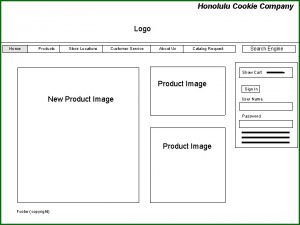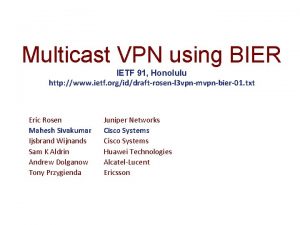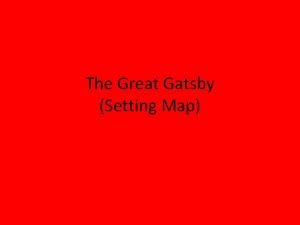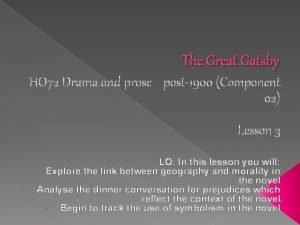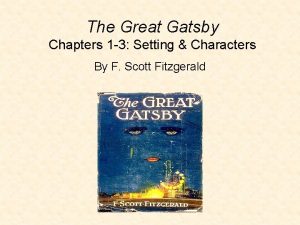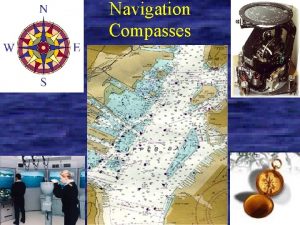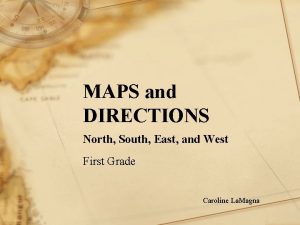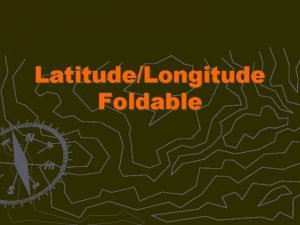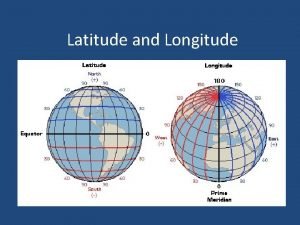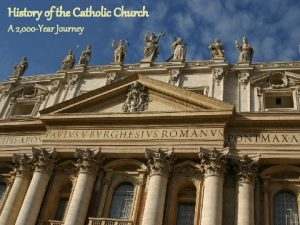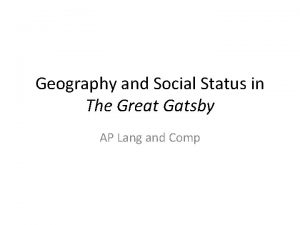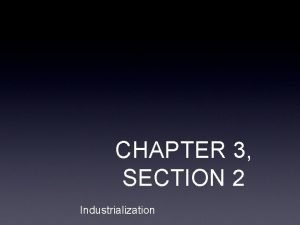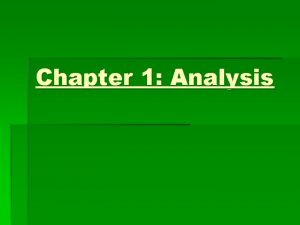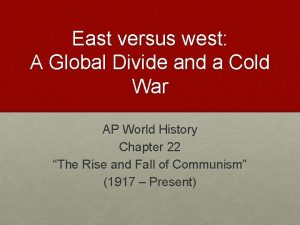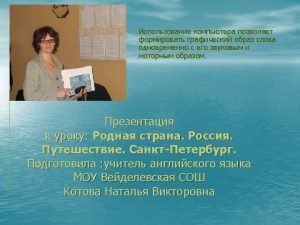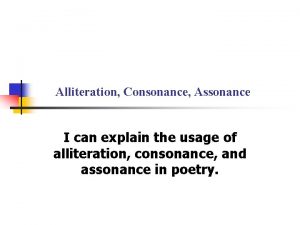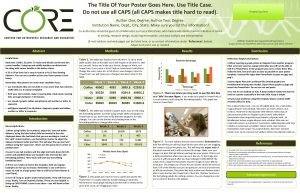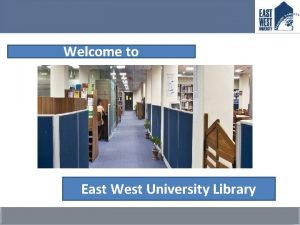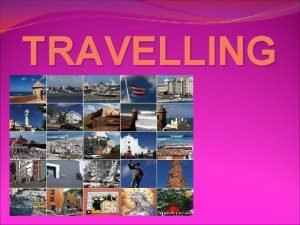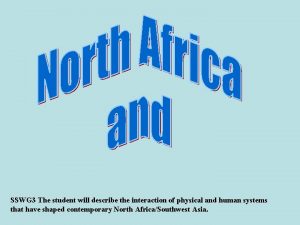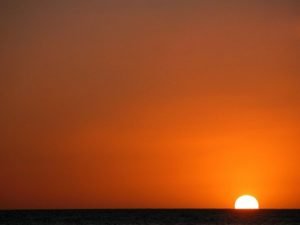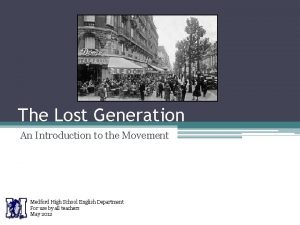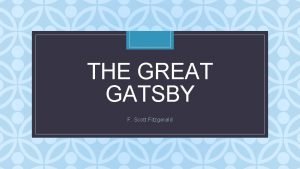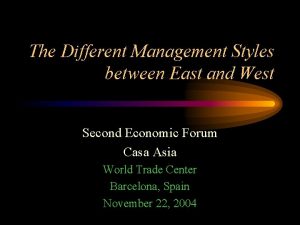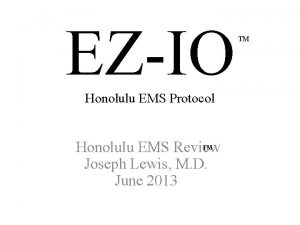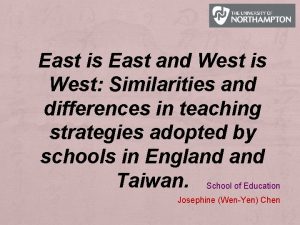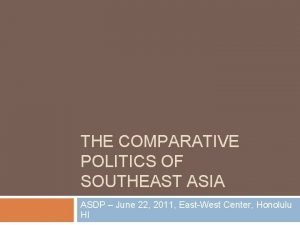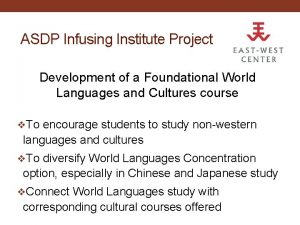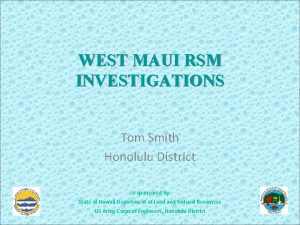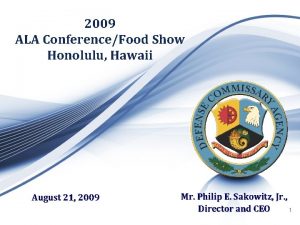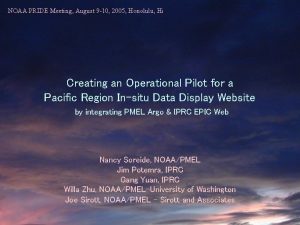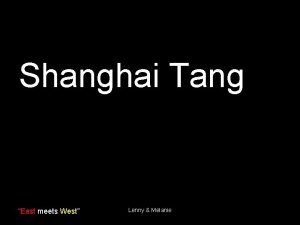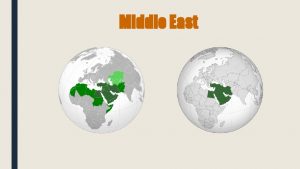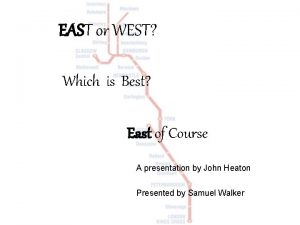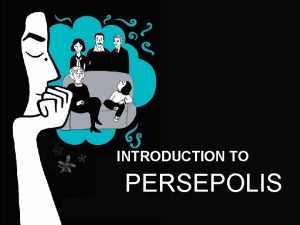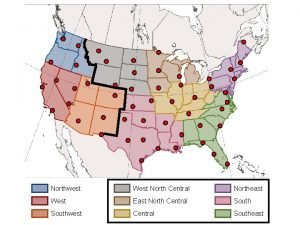East West Center ASDP Honolulu 9 august 2013












































- Slides: 44

East West Center - ASDP Honolulu, 9 august 2013 Rosana Pereira de Freitas Professor I Coordinator History of Art (new undergraduate degree) Fine Arts School Federal University of Rio de Janeiro

Infusing Chinese and Japanese Religion, Art and Literature into the Undergraduate Curriculum

Infusing Chinese and Japanese Religion, Art and Literature into the Undergraduate Curriculum In Brazil !!!

First infusion Islam in China In the required course History of Art II Unit 3: Islamic Art (the unit already exist, but we go until the Iberian Peninsula and stop there).

First infusion Islam in China In the required course History of Art II Unit 3: Islamic Art (the unit already exist, but we go until the Iberian Peninsula and stop there).

First infusion Islam in China In the required course History of Art II Infuse examples of sino-islamic art and architecture.

Second infusion Buddhism In the required course Oriental Arts: India/China/Japan BAH 364

c. 11 th century black sandstone, 28 x 75 cm Asian Art Museum, Berlim Second infusion Buddhism Infuse Buddhism as a key theme to connect the 3 units: India/China/Japan

c. 11 th century black sandstone, 28 x 75 cm Asian Art Museum, Berlim in Parallel Second cup of Buddhism Long-term project: • “Buddhist Art: from the aniconic times until Murakami’s Oval Buddha”

Last infusion Special Topic “Art & Text” (or “Word and Image”)there are electives courses called “Tópicos Especiais”

Reading Contemporary Asian Art through Literature (or the vengeance of the art historian)

Context The Fine Arts School of the Federal University of Rio de Janeiro is the oldest institution of arts in Brazil. Since colonial times we have had courses in Engraving, Painting, Sculpture, among others. But only in 2009, the degree in History of Art was created.

Context Even being a bicentenary institution – The Fine Arts School was created by the King of Portugal, when the Portuguese Royal Family moved from Portugal under Napoleon threat – it’s the first time that the institution has promoted a course in Asian Arts.

Challenge There is no text-book (no Clunas, no Masson, no Stanley-Baker) Ex. *Wong, Eva (tr), Seven Taoist Masters: a Folk Novel of China (Boston: Shambhala, 1990). We have 3 others books translated into Portuguese on the shelves of self-help books (“Feng Shui” etc. ) *Pauline C. Lee recommended readings but we have: **Watson, Burton (tr), Chuang Tzu (New York: Columbia University Press, 1968). Translated from English (!)

Rugendas, 1822 Tea Plantation The first Chinese Immigrants arrived in Brazil in 1810 (400)

A poster used in Japan to attract immigrants to Brazil. The first Japanese immigrants arrived in Brazil in 1908. Brazil is home to the largest Japanese population outside of Japan. “As of 2004, there were some 1. 6 million people of Japanese descent estimated to live in Brazil, accounting for 62 percent of the 2. 6 million Japanese and their descendents in total living abroad, according to the Association of Nikkei and Japanese Abroad”. The Japan Times Online, 2008 -01 -15

Invitation


Museu Dom João VI

Par de porta pincéis. Museu Dom João VI, Coleção Jerônimo Ferreira das Neves, Rio de Janeiro, Acervo n° 1398 A e 1398 B. 10 por 5, 8 cm, c. 1780 – 1850

Shan Xing I Escalada da Montanha Du Mu (803 – 852) “Por este caminho sinuoso de pedras escalo a montanha até o topo, onde faz frio. O caminho me conduz a um lugar de nuvens brancas onde vivem pessoas. Detenho a minha carruagem e sento-me para apreciar as árvores de bordo, cujas folhas geladas são tão vermelhas quanto as flores de primavera. ” (trad. Maria Fernanda Lochschmidt) Porta pincéis. Museu Dom João VI, Coleção Jerônimo Ferreira das Neves, Rio de Janeiro, Acervo n° 1400. 10 x 6 cm. ca. 1780 – 1850

Assumptions • Art and Literature are tied • The importance of narrative • The role of the spectator

Reading Contemporary Asian Art through Literature (or the vengeance of the art historian)

Reading Contemporary Asian Art through Literature Unit 1: “Under Confucians Eyes” Unit 2: Under Buddha’s Smile Unit 3: Under the Moonlight

A detail of “He Xie, ” an installation of ceramic crabs at the that refers to a dinner celebrating Ai Weiwei’s studio shortly before its razing by the Chinese government

Visitantes tentam ler A Book from the Sky. 4 mil blocos de madeira A Book from the Sky

In Chinese, the word for river crab, hexie, sounds very similar to that for “harmony”, the ideological buzzword of the current regime referencing the censorship of China

Zhang Huan – Confúcio (2011)

Zhang Huan – Buddha (2011)

Artist: Jocho Title: Amida Buddha Medium: Gold leaf and lacquer on wood Size: height 9'8" (2. 95 m) Date: Heian period, c. 1053 CE Source: Phoenix Hall, Byodo-in

Artist: Jocho Title: Amida Buddha Medium: Gold leaf and lacquer on wood Size: height 9'8" (2. 95 m) Date: Heian period, c. 1053 CE Source: Phoenix Hall, Byodo-in

• Pure Mariko Mori, Oneness, 2003; Pure Land 1996 -1998; Dream Temple, 1997 -1999

Old themes + Travel literature Yoshitomo Nara

Yoshitomo Nara

Travel literature Wenceslau de Moraes (Lisbon, 1854 - Tokushima, 1929)

Bibliography 1/4 • Bashô. Trilha estreita ao confim. São Paulo, Iluminuras, 1997 ("Oku no hosomichi") • Contos Populares Chineses. São Paulo: Landy, 2000. • Ching, S. C. & Wei, L. S. China – Lendas e Mitos. São Paulo: Kempf, 1984 • Cleary, T. Meditações taoístas. Brasília: Teosófica, 2001 (recolha de textos taoístas) • Cleary, T. O essencial de Confúcio. São Paulo: Best Seller, 1992 • Cleary, T. O essencial do Tao. São Paulo: Best Seller, 1992 • Cleary, T. Wen tzu. Brasilia: Teosófica, 2002. • Confucio Analectos. São Paulo: Pensamento, 1997.

Bibliography 2/4 • Confúcio Conversações. São Paulo: Ibrasa, 1999 (trad. Anne Cheng) • Franchetti, Paulo, org. Haikai; antologia e história. 3 a. ed. Campinas, SP, Ed. da Unicamp, 1996 • Gonçalves, R. (org) Textos Budistas e Zen Budistas. São Paulo: Cultrix, 1995. • Goga, H. Masuda & ODA, Teruko. Natureza - berço do haicai; kigologia e antologia. São Paulo, Empresa Jornalística Diário Nippak, 1996 • Guerra, J. J. Dicionário semântico de Chinês – Português. Macau, Jesuítas Portugueses, 1981. • Hamill, S. & Seaton, J. Chuang Tzu. São Paulo: Cultrix, 2000.

Bibliography 3/4 • Kenkô, Yoshida. A Arte de transformar tempo útil em tempo fútil. São Paulo: Landy, 2001. • Laozi - Tao te Ching, o livro do Caminho Perfeito. São Paulo: Pensamento, 1985 (trad. M Azevedo) • Laozi - Tao Te King São Paulo: Attar, 1995 • Laozi Daodejing. São Paulo: Hedra, 2002 (trad. M. Sproviero) • Laozi. Tao te king. São Paulo: Paulus, 2001 • Laozi - Tao te ching. São Paulo: Martins Fontes, 2004. (trad. B. Watson) • Meireles, C. Poemas Chineses. Rio de Janeiro: Nova Fronteira, 1996 • Merton, T. A Via de Chunag Tzu. Petropolis: Vozes, 1999.

Bibliography 4/4 • Merton, T. Místicos e mestres zen. Rio de Janeiro: Civilização brasileira, 1972. • Ming, L. I. O Despertar do Tao. São Paulo: Pensamento, 1992. • Savary, Olga, trad. Haikais de Bashô. São Paulo, Hucitec, 1989, 84 p. Antologia de haicais traduzidos do mestre japonês. • Watson, B. Chuang Tzu. São Paulo: Cultrix, 1988 • Wilhelm, R. A Sabedoria do I Ching. São Paulo: Pensamento, 1991 • Wilhelm, R. I Ching. São Paulo: Pensamento, 1986. • Wilhelm, R. Tao Te King. São Paulo: Pensamento, 1989.

Supplementary Bibliography 1/2 • Campos, H. (org. ) Ideograma. São Paulo: Cultrix, 1977. • Conze, E. Budismo. Rio de Janeiro: Civilização Brasileira, 1973 • Cooper, J. C. O Taoísmo. São Paulo: Martins Fontes, 1986 • Eliade, M. História das Crenças e idéias religiosas. Rio de Janeiro: Zahar, 1978. • Kudielka, Robert. "Arte do mundo – arte de todo o mundo? ". In: Novos Estudos, São Paulo, CEBRAP, n. 67, nov. /2003, p. 131 -142. • Kuniyoshi, Celina. Imagens do Japão: uma utopia de viajantes. São Paulo: Estação Liberdade; FAPESP, 1998.

Supplementary Bibliography 2/2 • Leite, José Roberto Teixeira. A China no Brasil: influências, marcas, ecos e sobrevivências chinesas na sociedade e na arte brasileiras. Campinas: Editora da Unicamp, 1996. • Sullivan, M. A Arte da China e do Japão. Lisboa, 1971. • The “Eating Crabs” Youth Book. In: Mann, Susan & Cheng, Yu-Yin. Under Confucian Eyes. Berkeley/Los Angeles/London: University of California Press • Thornton, Sarah. A visita ao Ateliê. In: Sete dias no mundo da arte. Rio de Janeiro: Editora Agir, 2010. • Zimmer, Heinrich. Mitos e símbolos na arte e civilização da Índia. São Paulo: Palas Athenas, 1989.

Further infusions How about a panel? Revisiting the Past, Living the Present, Envisioning the Future: Twentieth National Conference of the Asian Studies Development Program

Further infusions On the red tread: (non-)authorized genealogies Zhang Xiaogang b. Kunming, China, 1958. Lives in Beijing Bloodline, 1995

Obrigado(a)! • Islam in China in the unit Islamic Art • HAV 2
 East is east and west is west
East is east and west is west Honolulu cookie company whalers village
Honolulu cookie company whalers village Vpn honolulu
Vpn honolulu Baton rouge louisiana indianapolis indiana
Baton rouge louisiana indianapolis indiana Winds that blow over short distances are called
Winds that blow over short distances are called Laissez faire theory
Laissez faire theory Gatsby setting
Gatsby setting West egg and east egg
West egg and east egg Is nick carraway static or dynamic
Is nick carraway static or dynamic Chattisgarh is in east or west
Chattisgarh is in east or west Latitude and longitude aviation
Latitude and longitude aviation Gyro error examples
Gyro error examples West north east
West north east Angular distance of latitude
Angular distance of latitude Northern hemisphere map with latitude and longitude
Northern hemisphere map with latitude and longitude The meeting of longitude and latitude lines
The meeting of longitude and latitude lines East west hemisphere
East west hemisphere Important lines of latitude and longitude
Important lines of latitude and longitude Latitude is east to west
Latitude is east to west East west schism
East west schism West egg new york
West egg new york North south east west in our calm objective opinion
North south east west in our calm objective opinion North south east west in our calm objective opinion
North south east west in our calm objective opinion East west home is the best
East west home is the best East or west home is the best
East or west home is the best Linking east and west
Linking east and west Why is nick carraway made the narrator?
Why is nick carraway made the narrator? Kolkata east-west metro work progress
Kolkata east-west metro work progress Types of airspace
Types of airspace East west flight levels
East west flight levels North south east west leadership styles
North south east west leadership styles East west transport inc
East west transport inc Global east and global west
Global east and global west East or west home is best
East or west home is best Assonance consonance
Assonance consonance Make a poster with the title east or west
Make a poster with the title east or west East and west home is best function
East and west home is best function Library ewu
Library ewu East or west home is the best song
East or west home is the best song North east south west
North east south west East west interconnector
East west interconnector East to west casting crowns
East to west casting crowns West egg and east egg
West egg and east egg West egg and east egg
West egg and east egg North, south east west leadership styles
North, south east west leadership styles

